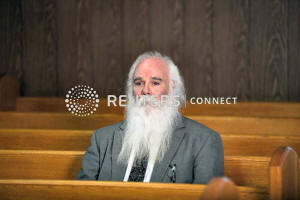Special Report: With 'judges judging judges,' rogues on the bench have
little to fear
 Send a link to a friend
Send a link to a friend
 [July 09, 2020]
By Michael Berens and John Shiffman [July 09, 2020]
By Michael Berens and John Shiffman
BARTLESVILLE, Oklahoma (Reuters) - District
Court Judge Curtis DeLapp was renowned for his hair-trigger temper.
Mispronounce his name, come to court a few seconds late, fail to rise as
quickly as he’d like – no slight was too small to set him off.
For almost a dozen years, DeLapp used his power to terrify people who
appeared before him, pressing contempt charges against defense
attorneys, prosecutors and even a prospective juror who brought children
to court when she couldn’t find daycare, court records show.
Another juror was fined $340.70 after she objected to how DeLapp was
treating people who appeared before him. “I never want to be a juror or
ever go back to court again,” said Carolyn Duffey Love, now 68. “He
treated me like a dog.”
In 2015, DeLapp grew incensed when he learned someone had dropped
sunflower seeds in his courtroom, according to witnesses. After scouring
footage from a courtroom security camera, the judge summoned a spectator
to his chambers, charged her with contempt and ordered her jailed for
four days.

Local attorneys had grown convinced that DeLapp was violating the
state’s judicial conduct code by abusing his authority. But they felt it
would be futile to file a complaint with the Oklahoma agency that
investigates judicial misconduct, because the state hadn’t filed charges
against a judge for misconduct since 2004. The lawyers also say they
worried that crossing DeLapp risked retaliation against both them and
their clients.
Not until 2018 – after DeLapp sentenced courtroom spectator Randa Ludlow
to nearly six months in jail for talking to her boyfriend during court –
did local lawyers find the courage to act.
They enlisted a lawyer from 50 miles away who seldom practiced in
DeLapp’s courtroom. And they worked collectively to build a voluminous
complaint alleging that DeLapp had unlawfully jailed not just Ludlow but
also many dozens of people in the prior two years alone. The complaint
also contained an explosive charge: that the judge may have fabricated a
court document to justify jailing Ludlow.
Had DeLapp fought the charges, he risked more than disgrace. If it could
be proved that he submitted a forged document to the supreme court, he
might land in prison.
Instead, DeLapp, 53, struck a deal. He resigned and agreed never again
to seek office as a judge. The case against him was dismissed. His state
pension and law license remained intact. And DeLapp received a written
assurance that neither his departure nor the settlement constituted an
admission to the “validity of any of the allegations.”
In leaving the bench, DeLapp became one of at least 341 judges across
the United States to escape punishment or further investigation in the
past dozen years by resigning or retiring amid misconduct allegations,
Reuters found.
DeLapp, who is still practicing law in Bartlesville, declined to
comment. In court documents, his attorney said the former judge denies
any wrongdoing.
The DeLapp case shines a light on one of the most opaque and dormant
judicial disciplinary systems in America. In Oklahoma, repercussions for
wrongdoing have been so unlikely that judges could behave with impunity.

Although each U.S. state has a judicial oversight agency to screen and
investigate misconduct complaints, their powers are often limited. In
most states, the ultimate disciplinary authority over a judge rests with
other judges.
In Oklahoma, the chief justice wields enormous discretion over judicial
misconduct cases. After the state’s Council on Judicial Complaints
completes a confidential investigation of a complaint about a judge, the
chief justice has the power to handle discipline privately – except in
rare cases serious enough to justify removing the accused judge from the
bench.
During their tenures, two former state supreme court chief justices told
Reuters, about one or two wayward judges a year were quietly summoned to
the supreme court. There, they received a tongue-lashing behind the
closed doors of the chief justice’s chambers. No official record was
kept of those meetings, the justices said.
As former Chief Justice Joseph Watt put it: “I’d much rather woodshed my
brethren in private and not in public.” He added: “How does that judge
feel, knowing he’s being taken to the woodshed in front of God and
everybody?”
Confidential justice for judges is common in America. At least 38 states
– Oklahoma among them – issue private sanctions when judges misbehave.
The name of the judge remains secret, and most of these states keep from
the public details of the transgression and the discipline. At a
minimum, most states release summary statistics of how many judges are
privately disciplined each year. Oklahoma doesn’t make that information
public.
This practice – law professor Stephen Gillers calls it “judges judging
judges” – undermines the system’s ability to prevent misconduct on the
bench.
Gillers said the killing of George Floyd, the Black man who died in May
under the knee of a Minneapolis police officer, has fueled concerns
about how judicial misconduct is handled, too. “The public has been
alerted as it never has been before to the way police misconduct is
concealed,” said Gillers. “The same is true for judges.”
When judges are the ones evaluating misconduct by other judges, they
“tend to be more sympathetic, more understanding, more forgiving” to
their own, said Gillers, a scholar on judicial ethics who teaches at New
York University.
Privacy also robs the system of a deterrent effect: Concealing the
punishment fails to discourage bad conduct by other judges, who may
never learn of the consequences, Gillers and other ethicists say.
That’s precisely the dynamic that played out in Oklahoma, local lawyers
say. Until Chief Justice Douglas Combs petitioned for DeLapp's removal,
Oklahoma hadn’t publicly filed misconduct charges against a judge in 14
years – the longest stretch of inaction of any state in recent decades.
In its investigation into judicial misconduct across America, Reuters
sought to quantify the personal toll inflicted by judges who break the
law or violate their sworn oaths. Over a dozen years, Reuters found at
least 5,206 people who were directly affected by a judge’s misconduct.
The victims ranged from individuals who were subjected to racist, sexist
and other abusive comments from judges to those illegally jailed.
“This is a broken system that absolutely empowered judges like DeLapp to
operate with impunity,” said Josh Lee, the out-of-town attorney who led
the effort to rein in DeLapp. “For more than a decade, not a single
judge was publicly disciplined. What kind of message does that send?”
Lee said that DeLapp “had no reason to fear that anyone would stop him.”
MASKING MISCONDUCT
The state of Washington is among a dozen states that handle judicial
discipline more openly.
In 1989, Washington voters abolished the practice of private sanctions.
Since then, every case brought against a judge by the Washington
judicial conduct commission is made public. Reiko Callner, the
commission's executive director, said judges should be treated the same
as anyone who appears before them.
“The norm is that anything that happens in a court has the name of the
participants on it – the names of a criminal defendant, the crime
victim, people involved in a lawsuit,” Callner said. “Why should a judge
who has been found to have violated the code that governs their conduct
be allowed to keep that fact from the public?”
Many state commissions say there are sound reasons to discipline judges
privately. “It’s quick, it’s inexpensive and you don’t have to hold a
public hearing,” said Cynthia Gray, director of the Center for Judicial
Ethics at the National Center for State Courts, an independent nonprofit
research and training organization.
Often, Gray said, states see benefits to keeping matters confidential.
“If it’s one-time, minor misconduct by a judge, and the judge shows
remorse, you can issue a private sanction or letter and then move on,”
she said. That means commissions can focus “on the judges who are out
there committing patterns of misconduct and are fighting every step of
the way.”
Still, a Reuters investigation found that private discipline has been
used to mask significant violations of the law. For example, in 2018,
state records show, a Texas judge failed to “maintain professional
competence” and illegally jailed indigent defendants. And in 2017, a
California judge engaged in sexual harassment and showed a “lack of
candor” when accused of misconduct, records show. Neither their names
nor their punishments have been made public.
In Colorado, the judicial commission has publicly disciplined four
judges since 2008 but has privately sanctioned 52. Among those whose
names and other identifying information remain hidden from the public:
judges disciplined for sexual harassment, for drunken driving, for
delayed rulings, and for demonstrating a “pattern of errors in handling
trials or issuing rulings that indicate a lack of competence.”
Granting anonymity to rogue judges is routine.
A Reuters examination of judicial misconduct nationally identified 3,613
cases from 2008 through 2018 in which states disciplined judges in
private, withholding from the public details of their offenses –
including the identities of the judges themselves.
Over the same period, 26 state oversight councils resolved more judicial
misconduct cases privately than publicly, the news agency found. In
Massachusetts, for instance, reviews of judicial conduct commission
annual reports show that about 9 in 10 judges disciplined were privately
sanctioned.
Some judicial oversight agencies take their independence and secrecy to
extremes.
California’s oversight agency went to court to try to prevent an audit
of its records, a review that ultimately discovered sloppy
investigations of judges. In Illinois, the agency misplaced or lost
hundreds of complaints, which have not been recovered or investigated.
Kathy Twine, who directs the Illinois Judicial Inquiry Board, declined
to comment on the lost files. Twine also would not provide routine
complaint and investigation statistics to Reuters – statistics disclosed
to the news agency by almost every other state.“We’re like an island,”
the official said. “We don’t have to disclose anything.”
A comparison between Oklahoma and a state of similar size highlights the
discrepancies in how judges are treated.
From mid-2004 to mid-2018, Oklahoma did not file misconduct charges
against any of its 600 judges, Reuters found. By contrast, the state of
Mississippi – with virtually the same code of judicial conduct and
almost the same number of judges – publicly sanctioned 75 judges in the
same period.
“I’m sure every state would like to think it has a judiciary that is
above reproach, but every profession’s going to have a few bad apples,”
said Darlene Ballard, who retired last week as director of the
Mississippi commission. “It sounds like other states like to keep their
problems in-house so that it appears to the public that they don't have
any bad judges.”
Steve Scheckman, who investigated misconduct cases in Louisiana and New
York, said states that report so few cases are failing in their primary
mission: to defend, before the public, the integrity of the justice
system.
“To think that there’s no misconduct in your state, you’re either really
naive, in denial or protecting people,” he said.
Former Oklahoma Justice Steven Taylor disputes such characterizations.
Taylor, who served on the state’s top court from 2004 through 2016, said
he was proud that the state had so few cases of public discipline. To
him, the small number of cases doesn’t demonstrate weak oversight. It
shows “a judiciary in Oklahoma that is ethical, doing their work and
highly disciplined.”
“If we had 6o or 70 cases, I would be ashamed or embarrassed,” Taylor
said.
As chief justice in 2011 and 2012, Taylor recalled, he visited the
Washington County courthouse in Bartlesville, where he met Judge DeLapp
and others. Taylor said no one mentioned any concerns about how DeLapp
ran his courtroom.
[to top of second column]
|

Lawyer Marty Meason poses for a portrait at the Osage County
District Court in Pawhuska, Oklahoma, U.S. November 19, 2019.
REUTERS/Nick Oxford

But Reuters identified scores of contempt charges issued by DeLapp
in traffic and other cases before, during and after Taylor’s time
leading the bench. Some dated back a decade. In 2008, for instance,
DeLapp charged a defendant with contempt for “being vocal” after the
man protested because he had “no money to pay towards his fines &
court costs,” according to a court record.
Taylor said he was “extremely disappointed” when he heard in 2018
that DeLapp had acted so inappropriately for so many years. He also
was surprised that lawyers had remained silent for so long.
“Why didn't someone report this?” the former justice asked.
The local lawyers who kept quiet for years offer a simple answer,
rooted in the state’s desire to keep judicial misconduct secret: An
unchecked judge has the ability to cow his community.
In Bartlesville, the Washington County seat, four judges hear
criminal and civil cases, with traffic infractions representing the
bulk. The city of 36,000 is an hour north of Tulsa. The courthouse
is convenient for visitors, who park for free just steps from the
entrance. It also is an easy place for a judge to escape scrutiny.
That’s because in Washington County and thousands of other
courtrooms nationally, there is no requirement to record or
transcribe most proceedings. Employing a stenographer or recording
the proceedings is considered too expensive and largely unnecessary
for the assembly-line pace of misdemeanor cases that make up most of
the court’s business.
This lack of an official and detailed record posed an obstacle to
the local attorneys alarmed by DeLapp’s behavior. Absent transcripts
or recordings to corroborate their concerns, six lawyers told
Reuters, they worried that a complaint alleging misconduct would
come down to their word against the judge’s.
The local lawyers say they felt vulnerable to reprisal. DeLapp
wielded authority to appoint attorneys to cases involving indigent
defendants. They say the per diem pay for this work made the
difference for some lawyers between insolvency and eking out a
living.

That explanation bothers Taylor, the former state high court
justice. “It's sad that the lawyers were intimidated,” Taylor said.
“Part of the hallmark of being a lawyer is speaking truth to power.
They should have spoken up.”
But many of those lawyers say they weren’t simply concerned about
themselves. They worried that, if DeLapp got wind of a complaint, he
might take it out on defendants as well. “It’s not just your
livelihood at stake. It’s also clients,” said defense attorney Marty
Meason, who practiced before DeLapp and once ran unsuccessfully
against him for district judge. “Nobody wanted to take on the
system.”
That changed in early 2018, when DeLapp ordered Randa Ludlow jailed
for five months and 27 days in jail. Her alleged offense: talking
during court with her boyfriend, a traffic defendant. Ludlow
declined to comment.
The sentence seemed outlandish to Meason and other lawyers who had
questioned DeLapp’s behavior for years. They suspected DeLapp broke
the law by failing to afford Ludlow a hearing to challenge the
contempt order, violating a basic constitutional right. They also
believed he’d failed to properly document his reasons for jailing
her. Whether DeLapp followed proper procedure in punishing Ludlow
would become a key component in the misconduct complaint against
him.
A few days after Ludlow was jailed, the lawyers decided to reach out
to Lee, an attorney whose office was about an hour's drive from
Bartlesville – and thus had less to fear because he didn’t regularly
appear before DeLapp.
Lee remembers the call his firm received from a Washington County
lawyer. The message was clear: You have to help us stop this judge.
“Everyone feared retaliation,” Lee said. “I worked far enough away
that I might be safe. Plus, I was the only one crazy enough to do
it.”
A DISPUTED DOCUMENT
About seven weeks after DeLapp had jailed Ludlow for contempt, Lee
sought her release by filing a writ of habeas corpus with the state
supreme court challenging her detention. The high court quickly
heard the case in Oklahoma City.

At the hearing, DeLapp told the court that he had been unable to
locate the specific document legally necessary to jail Ludlow. In
the document, called a Contempt Court Minute, judges must lay out
the rationale for the order. The document must also be time stamped
and signed.
Shortly after the supreme court hearing, DeLapp notified the high
court that he had located the missing record. Nonetheless, the high
court voided DeLapp’s contempt order, and Ludlow was immediately
released.
The case as it related to Ludlow was over. But now, Lee had grown
suspicious of DeLapp, in particular the judge’s claim that he had so
quickly located the missing Contempt Court Minute he used to justify
jailing Ludlow. When DeLapp produced the missing Contempt Court
Minute, the document seemed odd, Lee recalled.
It included a stamp that made no sense. It was dated two days before
DeLapp claimed to have created the document. In other words, it
appeared to be backdated, and poorly at that.
Lee wondered: Had DeLapp fabricated the document because one had
never been filed in the first place? In late March, Lee received a
call from Meason, the Bartlesville attorney who was quietly helping
him build a misconduct case against DeLapp and harbored similar
suspicions.
“I found the evidence,” Meason recalled telling Lee. “We’ve got
him.”
DeLapp, Meason explained, had often used security cameras to monitor
the conduct of people in the courthouse. He had used footage from
one camera to identify the sloppy sunflower-seed eater.
There was also a security camera in the clerk’s office. Playing a
hunch, Meason went to the sheriff’s office and requested a copy of
weeks of video beginning in February 2018. To his surprise, he said,
a staffer quickly handed over the footage on a flash drive.
Reuters reviewed the video, which has never been made public. It
shows DeLapp leaving the clerk’s office with files. A clerk then
leaves her desk. She returns later with what appears to be a
single-page document. The clerk examines the page, then stamps it in
two places.
Meason and Lee say they were convinced that the document shown on
the security tape was the same Contempt Court Minute that DeLapp
submitted later that day to the high court. The footage, they
believe, showed the clerk backdating the document, apparently to
make it look as though it had been filed at the time DeLapp issued
his contempt order.
Lee submitted a 44-page complaint against DeLapp with the state
judicial council, characterizing the contempt document as “suspect
at best.” Meason mailed a copy of the unabridged footage to the
oversight council. Lee captured key frames and created a video
presentation, which he also submitted. “I wanted to make it simple
for them,” Lee said.
The state’s judicial council investigated Lee's complaint about
DeLapp. According to council director Taylor Henderson, the matter
was then forwarded to Chief Justice Combs with a recommendation that
DeLapp be removed from office. The council director declined further
comment but records show that a short while later, Combs moved to
oust DeLapp, publicly filing a 20-page petition with the Court of
Judiciary, the nine-member tribunal that has the authority to remove
judges.
In the petition, the chief justice accused DeLapp of “gross neglect
of duty,” “oppression in office” and “complete disregard” for the
law. The justice also criticized DeLapp for abusing his judicial
power and declared him unfit for office.
In a section titled “Falsified Court Documents and
Misrepresentation,” Combs chastised DeLapp for “gross
misrepresentation” of the contempt of court document. If DeLapp
created the document and pretended it was “newly discovered,” it may
have constituted “a grossly intentional misrepresentation to the
Oklahoma Supreme Court” – one that could be construed as a felony.
This was not the first time that DeLapp had failed to properly file
a contempt of court document, then produced it after the fact, Combs
concluded. In the 2015 case of a woman jailed for eating sunflower
seeds in court, DeLapp waited more than two years before he
“drafted” a required sentencing order. DeLapp filed the missing
document “only after” his misuse of contempt powers came to light in
2018 in the Ludlow case, Combs wrote.
Combs detailed more allegations against DeLapp. One involved a
father and son who became lost in the hallway of DeLapp’s
courthouse. The boy asked DeLapp for directions to another
courtroom, and the judge yelled at him, according to witnesses.
DeLapp threatened that if the boy couldn’t find his way, “he could
sit his ass in jail,” Combs wrote.
And the chief justice cited evidence that DeLapp had inappropriately
contacted the county attorney’s office about a deferred prosecution
agreement for DeLapp’s son, who was charged with traffic violations.
Rather than fight the misconduct allegations, DeLapp resigned
without admitting to any wrongdoing.
Not every state is forgiving of judges facing misconduct charges who
opt to resign. California, Texas and a dozen other states have
pursued disciplinary cases and impose sanctions even after judges
leave the bench.
West Virginia is among them. On average, West Virginia disciplines
about four or five judges each year. Often, one or two of these
cases involves a judge who resigned during a misconduct
investigation, said Teresa Tarr, counsel for the state’s judicial
oversight commission.
“It would be very easy for us to dismiss cases if they resign,” Tarr
said. “I think the right thing to do is to hold them accountable,
because it gives the public the understanding that the judiciary as
a whole is not going to tolerate misbehavior. It also lets the other
judges know what’s acceptable conduct and what’s not.”
Not so in Oklahoma, where the focus is on protecting the judge, not
informing the public. “We want to try to self-police,” said Watt,
the former chief justice. Handling matters informally is “the best
way to take care of” wayward judges, “and not drag them through the
mud.”
Settlement agreements like the one Oklahoma approved for DeLapp do
more than permit accused judges to walk away without admitting
guilt. When an accused judge leaves the bench, the commission’s
investigation into misdeeds ends – even if other wrongdoing is
suspected.
Because state judicial investigations are sealed, the public is left
to wonder about a judge's culpability. Potential victims of
misconduct may go undiscovered. And commission officials are
prohibited from discussing cases under penalty of law. That silence
can empower an accused judge to declare his or her innocence without
citizens ever knowing the facts of the case.
DeLapp resigned to preserve his livelihood, his wife posted on
Facebook. “He could’ve fought it, which he wanted too [sic] but did
not want to risk losing his retirement, pension, Bar license, etc.,”
she wrote.
In one of his last acts as a judge, DeLapp issued a statement in
which he praised his judicial accomplishments and said he was
leaving the bench with "a heavy heart but clear conscience."
(Reporting By Michael Berens and John Shiffman. Additional reporting
by Andrea Januta, Caroline Monahan, Isabella Jibilian and Blake
Morrison. Edited by Morrison.)
[© 2020 Thomson Reuters. All rights
reserved.] Copyright 2020 Reuters. All rights reserved. This material may not be published,
broadcast, rewritten or redistributed.
Thompson Reuters is solely responsible for this content. |